Wasb 2008
- 1. 21 st Century Skills: Is Your District Preparing Students for the Demands of the Future? www.cesa1.k12.wi.us www.wicenterfored.org
- 2. Key question for most parents today: How do I insert my child into the middle class or higher?
- 3. Share with me your thoughts about the purpose and goals of American public education.
- 4. We are suffering from a “quiet crisis” or a “creeping crisis”. Our crisis is not the result of a one dimensional change. There is no one single wakening event, like Sputnik. The problem is the problems are like building a mosaic tile, they fall into place one tile at a time. None by itself sufficient to provoke action. The collection of problems however creates a disturbing picture.
- 5. Our collective reaction thus far seems to presuppose the citizens of the United States are entitled to a better quality of life than others, and that all Americans have to do is to circle the wagons to defend that entitlement. Such a presupposition does not reflect reality and neither recognizes the dangers nor seizes upon the opportunity of the current circumstances.
- 6. “Jobs we believed would always be available and even plentiful are disappearing. Most jobs have not fled across any border; they simply dissolved through efficiencies in process engineering, technology, and corporate strategy.” The Jobs Revolution: Changing How America Works
- 7. Outsourcing accounts for less than 10% of the American jobs lost in the past three years. Outsourcing Facts
- 8. Troubled American Economy OR Troubled Workforce
- 9. Here are the facts: In the past decade factory productivity has increased 47% in America. Historically, 12 years of school, then work. New model New skill set New attitudes and dispositions
- 10. Education: A Primary Economic Driver Education is workforce development. Workforce development is economic development. Education yields a phenomenal “ROI” (return on investment). Education Education Education Education Education Education Education
- 11. The time to act is now. “ We are not planting alfalfa here, we are planting the forests for the future.” ~ David Ward, CEO of Northstar Economics “ Even if you are on the right track, you will get run over if you just sit there.” ~ Will Rogers
- 12. Name this country . . .
- 13. Richest in the World Largest Military Center of world business and finance Strongest education system World center of innovation and invention Currency the world standard of value Highest standard of living
- 14. England.
- 15. In 1900.
- 16. Independence Revolution (This revolution took five generations *) Agricultural Revolution (This transformation took five generations) Industrial Revolution (This transformation took five to six generations) Information Revolution *Remember the drastic changes in life expectancies during this period moving from 40 years to slightly over 70 years for current generations
- 17. Awareness Ambiguity Anxiety Awareness + Ambiguity + Anxiety = Action The Three A’s
- 18. “ The transcending economic consideration as we move into the 21 st Century is the globalization of the world’s economy into a single world market. The global economy is of paramount importance but no one yet knows how it will work. I think that is good news. If we don’t know how it works we can’t fix it” John Naisbitt - Megatrends China knows education is the platform on which you build a sound economy. A global economy is the reality. We are experiencing a jobs revolution.
- 19. Shortage of Workers, Shortage of Skills Today we have too many people willing to work in America. Tomorrow, we will not have enough. “ Boomers” will start retiring Women will not be replenishing the pool in the record numbers of the past The “skill gap” will set in
- 20. Source: Bureau of Labor Statistics
- 21. Source: Employment Policy Foundation analysis and projections of Census/BLS and BEA data.
- 22. Projected Skilled and Unskilled Worker Gap in 2010 and 2020 Source: Anthony Carnevale, NAM White Paper, Reported in Business 2.com 21 million 7 million Total Skilled & Unskilled Worker Gap 7 million 1.7 million Unskilled Worker Gap 14 million 5.3 million Skilled Worker Gap 2020 2010
- 23. Business Summit on 21 st Century Skills Focus Groups Small group discussions were designed to encourage business leaders to answer focus group questions. • What are the 21st century skills that will sustain and grow a vibrant, global economy? • What should be expected of today’s students so they can be effective citizens and leaders in our communities?
- 24. What Did We Find? In identifying the skills students will need for the 21 st century, business leaders most often cited: • learning, • thinking, and • life skills.
- 25. They also stressed an emphasis on: • critical-thinking and problem solving, • collaborative communication skills, • people skills, • contextual learning skills, • personal responsibility, • ethics, and • adaptability (nimbleness).
- 26. Five Major “Needs” 1. Well-rounded and adaptable individuals. 2. Balance of academic content and real- world skills. 3. Emphasis on 21st century skills. 4. Partnerships between schools, business, communities, and government. 5. Collaboration and team-building skills.
- 27. World Class Academic Standards The Wisconsin Model Academic Standards were established in 1998 for 18 subject areas. The Department of Public Instruction has begun a process of reviewing the model academic standards, building on the work of State Superintendent Burmaster’s High School Task Force. <http://www.dpi.wi.gov/sprntdnt/hstask.html>.
- 28. News Flash: More Education = Less Unemployment Source: Carnevale, Anthony P. and Richard A. Fry. Crossing the Great Divide . Educational Testing Services, 2000.
- 29. The Dynamic That Education Can’t Manage: Speed Facts to ponder: Knowledge is being outdated at rates that are still expanding. While the number of new careers is expanding, the life span of applicable knowledge is decreasing. What are the “targets” for K12 public education?
- 30. The Problem: No single institution is charged with the responsibility to manage the change of the jobs revolution. Without cooperation, collaboration and regionalism, the relationships and roadmaps will not take place.
- 31. The Action Plan: Schools need to be seen as the leaders in the economic and workforce development of this country. Effective education is a right in our country, not merely an opportunity.
- 32. It translates to this: World Class Schools = A Better Workforce = A Stronger Economic Future
- 33. It is not knowledge we lack. It is leadership. A major purpose of our public schools: To prepare Americans for the world of work so they may support their families and acquire a quality of life that exceeds preceding generations.
- 34. Students, Schools and 21 st Century Teaching and Learning Digital Natives in a Digital Immigrant world. Paradigm changing from “being taught by us” to “teaching themselves through our guidance” SELF DIRECTED LEARNERS - Rubric for learners on website
- 35. Millenials/Digital Natives Want to Learn With technology With each other Online In their time In their place Doing things that matter
- 36. teach by One Size Fits All One Thing at a Time Linear Stories Presenting & Telling Delivering content Face-to-face Doing & Gameplay learn from Multi-tasking Personalized to Them Random Access & Exploring Options Being Engaged Going Online Digital Immigrants Digital Natives
- 37. But, given the right conditions, Students eagerly learn from: each other discussions researching solving problems and problem finding finding their own solutions sharing with their peers listening to their peers seeing and dialoging with experts
- 38. Nouns Use Blogs Use Podcasts Use Photoshop Verbs Share Communicate Create Digital Immigrants Digital Natives
- 39. BOREDOM ENGAGEMENT Kids teaching themselves (with guidance) TECHNOLOGY REQUIRED Kids being taught TECHNOLOGY DOESN’T HELP Old Paradigm New Paradigm
- 40. The e-Life Digital Natives
- 41. It’s important that teachers DON’T WASTE TIME Learning to Create With New Tools The students can learn new tools! (and they want to) “ Don’t try to keep up with the technology -- you can’t” – A 14 year old girl “ You’ll only look stupid.” – A 14 year old girl
- 42. Teachers need to: Understand new technologies Help students evaluate quality Figure out what tools will help
- 43. 6 Keys to Engagement of Today’s Student Being respected Creating – what they imagine Voicing their opinions Making decisions / Having control Collaboration, and competition Interacting with and affecting the world –making a difference
- 44. Let Students do what they do well Use the technology, find content SHARE THE WORK Let Teachers do what they do well Evaluate, find quality, provide context
- 45. 21st Century Learners “ Today’s education system faces irrelevance unless we bridge the gap between how students live and how they learn.” “ Schools are struggling to keep pace with the astonishing rate of change in students’ lives outside of school.” Partnership for 21st Century Skills (2003)
- 46. Framework for Learning: Partnership for 21 st Century Skills
- 47. 21 st Century Literacy From: What should students be able to know and do about technology and information literacy? TO: What skills and competencies will our students need to live, learn and thrive in a workplace that demands innovation and creativity?
- 48. Framework: 21st Century Learning Core Subjects
- 49. Core Subjects and 21 st Century Themes English Language Arts World languages Arts Mathematics Economics Science Geography History Government and Civics Global awareness Financial, economic, business and entrepreneurial literacy Civic literacy Health literacy
- 50. Framework: 21st Century Learning
- 51. Life and Career Skills Flexibility & Adaptability Initiative & Self-Direction Social & Cross-Cultural Skills Productivity & Accountability Leadership & Responsibility
- 52. Learning and Innovation Skills Creativity and Innovation Skills Critical Thinking and Problem Solving Skills Communication and Collaboration Skills
- 53. Core Subjects Current intersections? Should there be intersections? If so, at what level(s): State Standards/Benchmarks District Curriculum Classroom 21st Century Learning & Outcomes Learning and Innovation Skills Life and Career Skills ICT Literacy Skills
- 54. 21st Century Support Systems Standards & Assessment Curriculum & Instruction Professional Development Learning Environments
- 55. Core Content Areas Info Media & Technology Skills 21st Century Learning & Outcomes Life & Career Skills Learning & innovation Skills Standards and Assessment Curriculum and Instruction Professional Development Learning Environments
- 56. How will the intersections happen?
- 57. Thought out policies for technology access and use (Ban?, Restrict?, Open with safeguards?) Professional development towards the Learning Specialist Utilizing proficiency based teaching and learning
- 58. Preparing students to succeed Agility at learning skills is what differentiates a 21st Century citizen and learner from a 20th Century citizen and learner. The illiterate of the 21st century will not be those who cannot read and write, but those who cannot learn, unlearn and relearn. Alvin Toffler (2000) Has your district positioned and leveraged itself for the reality of the future of our students?
- 59. Categories of the New Middle Class Great collaborators Great leveragers (of technology) Great explainers Great localizers Great adapters Passionate personalizers Anything green Thomas Friedman: The World Is Flat
- 60. Regional Workforce Alliance 21 st Century Learning Initiative Milwaukee 7 Research & Data Analysis Research & Data Analysis Research & Data Analysis Strategic Planning Strategic Planning Strategic Planning Regionally-Focused Initiatives Regionally-Focused Initiatives Regionally-Focused Initiatives Expertise Inventory PK-16 Education Curriculum Development Skill Training Expertise Inventory Workforce Development Business Employment Solutions Worker Skill Advancement Expertise Inventory Economic Development Business Economic Solutions Workforce Preparation REGIONAL COLLABORATIVE SOLUTIONS IDENTIFIED REGIONAL NEED
- 61. The Center For Education Innovation and Regional Economic Development Mission Through regional economic development and the transformation of public education to world class twenty first century schools, the Center will improve the quality of life in Southeast Wisconsin.
- 62. What are our Hopes and Aspirations? “ We fundamentally believe that with this game changer strategy, we will be poised to break the cycle of poverty and economic despair encountered by many of the youth of the seven county region. “ With increased economic standing and hope comes the opportunity to improve family support, reduce crime, stimulate regional economic growth through better skilled workers, who will in turn produce civic and community outcomes that will improve the region’s quality of life for all.”
- 63. Center Purpose The Center for Education Innovation and Economic Development is a game changer organization and service that enables public education to transform and evolve to promote economic development through 21st century skills and the preparation of our youth for the world of work.
- 64. What will the Center Do? A Leadership Brokerage: Designed to facilitate, train and support business and education leadership for future growth.
- 65. A Dynamic Catalyst: Focused on the change process and serving as a change agent.
- 66. A Transmission Line: Providing connections and access for broad regional educational services and business community interactions.
- 67. A Connector: Where regional educational services and the business community intersect and collaborate.
- 68. A Clearinghouse: For best practice and innovative design that produces higher quality results.
- 69. An Incubator: That houses think tanks, symposiums, research design, and other solution driven responses dedicated to changing how we do business.
- 70. The Game Changer: To promote a philosophy and a plan for changing the focus and resource allocations to better meet the future needs.
- 71. “ They’ve got great defensive strategies, and they’re doing a magnificent job of managing decline”, said a longtime industry executive. “The trouble with doing a great job of managing decline is that you’re going to decline” (comments about paper industry in WI) --Milwaukee Journal Sentinel 12/09/07 Improving education must be the top priority “ There are many needs in the region, but nothing is more important than developing school systems that adequately prepare kids for the world they will inherit. This a challenge for us all.” -- Milwaukee Journal Sentinel 7/28/07
- 72. Services for Education Innovation Enterprise for World Class Schools Organizational Development Systems Development 21 st Century Learning Program Economic Development Strategic Business Partnership Program Alignment of PK-16 Regional Economic Development Future Business Needs Profile Accelerated Solutions Lab
- 73. The First Strand We are out of sync as the workplace is gradually changing. New skill sets are required Fewer lower skill jobs Changes in what workers need to know and how to use it
- 74. The Second Strand A New Understanding of Effective Education Mistaken Assumptions About How People Learn They are not passive receivers of wisdom Breaking down learning into smallest sequences Getting the right answer is not the only purpose of learning
- 76. What can THE CENTER do for you? Bruce Connolly [email_address] Kathy Onarheim [email_address]
- 77. Bruce Connolly Bruce brings over thirty years of innovation and game changer strategies to the Center. He has served on numerous boards and in leadership roles of several statewide organizations including WASCD, WSPRA, Fair Aid Coalition as well as many task forces and statewide committees. His background in education includes time as a teacher, principal, and district administrator in Illinois and Southeast Wisconsin. As a trained Strategic Planner, he has developed Balanced Scorecards and Strategy Mapping for schools as well as Business Process Plans. He is well versed in Breakthrough Performance Planning. He was involved with the establishment of the first Youth Apprentice Model in the State of Wisconsin. Bruce was one of the founders of the Sally Ride Academy in 1995 and still serves today as its president. Bruce holds advanced degrees from Northern Illinois University and the University of Northern Iowa. bconnolly@cesa1.k12.wi.us Kathy Onarheim Kathy has been in the education field since 1980. She has been with CESA #1 since 2004. Prior to that she worked for Milwaukee Public Schools in a variety of areas, including the Director of School Technology Support. Ms. Onarheim has been involved with local, state and national projects including Harvard University’s River City Project, Preparing Tomorrow’s Teacher to Use Technology, TEACH Wisconsin, Star Schools Project, and the Distributed Learning Objects Laboratory. She has also coordinated and maintained partnerships focused on technology and learning with Harvard Graduate School of Education, UW-Madison, Academic Co-Lab and UW Parkside, among others. Kathy received a B.A. from Alverno College. She received a Masters of Science in Educational Change and Technology Innovation from Walden University, Minneapolis, MN. [email_address]
- 78. Selected Readings/References The Jobs Revolution: Changing How America Works Steve Gunderson, Roberts Jones, Kathryn Scanland Falling Behind Robert H. Frank The Progress Paradox Gregg Easterbrook







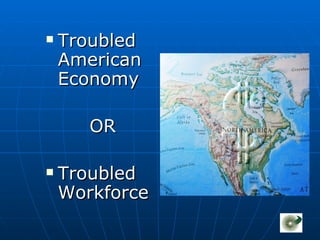
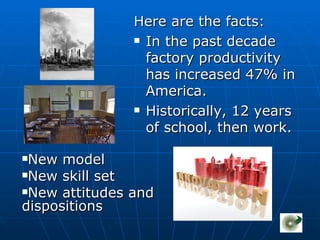



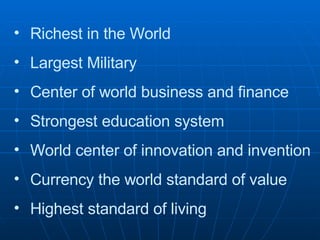












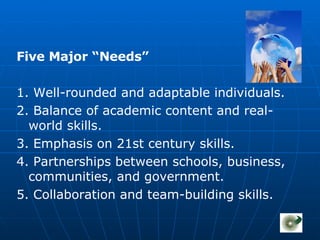








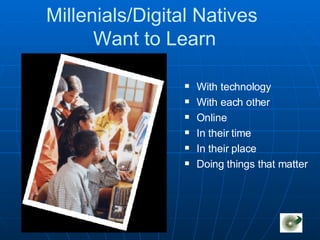




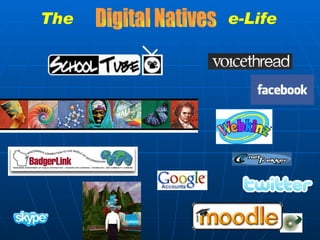



































![What can THE CENTER do for you? Bruce Connolly [email_address] Kathy Onarheim [email_address]](https://image.slidesharecdn.com/wasb-2008-1201289451960339-4/85/Wasb-2008-76-320.jpg)
![Bruce Connolly Bruce brings over thirty years of innovation and game changer strategies to the Center. He has served on numerous boards and in leadership roles of several statewide organizations including WASCD, WSPRA, Fair Aid Coalition as well as many task forces and statewide committees. His background in education includes time as a teacher, principal, and district administrator in Illinois and Southeast Wisconsin. As a trained Strategic Planner, he has developed Balanced Scorecards and Strategy Mapping for schools as well as Business Process Plans. He is well versed in Breakthrough Performance Planning. He was involved with the establishment of the first Youth Apprentice Model in the State of Wisconsin. Bruce was one of the founders of the Sally Ride Academy in 1995 and still serves today as its president. Bruce holds advanced degrees from Northern Illinois University and the University of Northern Iowa. bconnolly@cesa1.k12.wi.us Kathy Onarheim Kathy has been in the education field since 1980. She has been with CESA #1 since 2004. Prior to that she worked for Milwaukee Public Schools in a variety of areas, including the Director of School Technology Support. Ms. Onarheim has been involved with local, state and national projects including Harvard University’s River City Project, Preparing Tomorrow’s Teacher to Use Technology, TEACH Wisconsin, Star Schools Project, and the Distributed Learning Objects Laboratory. She has also coordinated and maintained partnerships focused on technology and learning with Harvard Graduate School of Education, UW-Madison, Academic Co-Lab and UW Parkside, among others. Kathy received a B.A. from Alverno College. She received a Masters of Science in Educational Change and Technology Innovation from Walden University, Minneapolis, MN. [email_address]](https://image.slidesharecdn.com/wasb-2008-1201289451960339-4/85/Wasb-2008-77-320.jpg)
